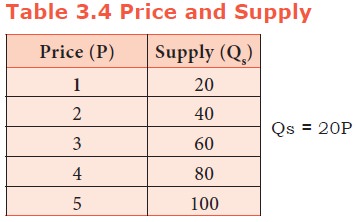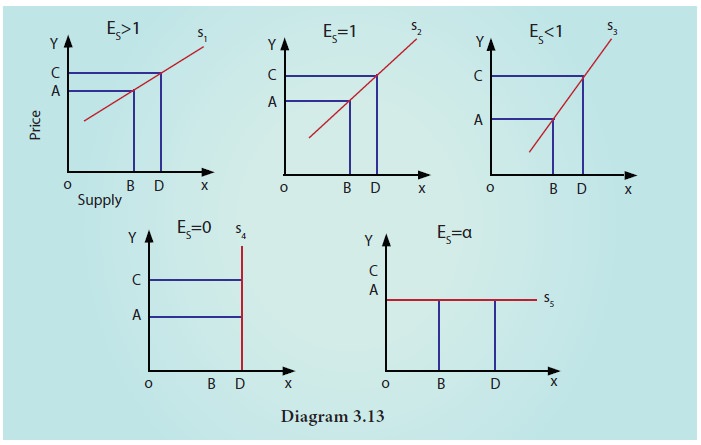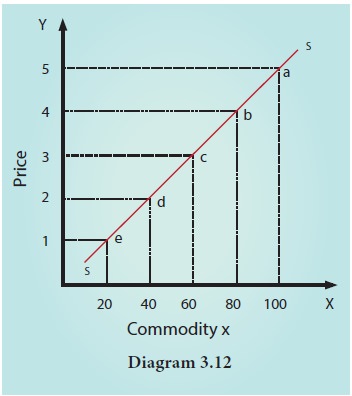Economics - Law of Supply | 11th Economics : Chapter 3 : Production Analysis
Chapter: 11th Economics : Chapter 3 : Production Analysis
Law of Supply
Law of
Supply
Law of
Supply is associated with production analysis. It explains the positive
relationship between the price of a commodity and the supply of that commodity.
For example, if the price of cloth increases, the supply of cloth will also
Definition
The Law
of Supply can be stated as:
“Other things remaining the same, if the
price of a commodity increases its quantity supplied increases and if the price of a commodity decreases, quantity
supplied also decreases”.
1. Supply Function
The
supply of a commodity depends on the factors such as price of commodity, price
of labour, price of capital, the state of technology, number of firms, prices
of related goods, and future price expectations and so on. Mathematically the
supply function is
Qs
= f (Px, Pr, Pf, T, O, E )
Where Qs
= Quantity supplied of x commodity
Px
= Price of x Commodity
Pr
= Price of related goods
Pf
= Price of factors of production
T =
Technology
O =
Objective of the producer
E =
Expected Price of the commodity.
Assumptions
Law of
Supply is based on the following assumptions.
·
There is no change in the prices of factors of
production
·
There is no change in price of capital goods
·
Natural resources and their availability remain the
same
·
Prices of substitutes are constant
·
There is no change in technology
·
Climate remains unchanged
·
Political situations remain unchanged
·
There is no change in tax policy
Explanation
Suppose
that the supply function is
Qs = f(P) or Q = 20P
P is an
independent variable. When its value changes, new values of Qs can
be calculated.
Supply Schedule
A supply
schedule shows the different quantities of supply at different prices.
This
information is given in the supply schedule given below.
Price and Supply

2. Supply Curve
A supply
curve represents the data given in the supply schedule. As the price of the
commodity increases, the quantum supplied of the commodity also increases. Thus
the supply curve has a positive slope from left to right. (see diagram 3.12.)
The
quantum supplied of commodity x is represented on X axis. And the price of the
commodity is represented on the Y axis. The points such as e, d, c, b and a on
the supply curve SS’, represent various quantities at different prices.
3. Factors determining supply
Price of the commodity
Higher
the price larger the supply. Price is the incentive for the producers and
sellers to supply more.
Price of other commodities
The
supply of a commodity depends not only upon its price but also price of other
commodities. For instance if the price of commercial crops like cotton rise,
this may result in reduction in cultivation of food crops like paddy and so its
supply.
Price of factors
When the
input prices go up, this results in rise in cost and so supply will be
affected.
Price expectations
The
expectation over future prices determines present supply. If a rise in price is
anticipated in future, sellers tend to retain their produce for future sale and
so supply in present market is reduced.
Technology
With
advancement in technology, production level improves, average cost declines and as a result supply level increases.
Natural factors
In
agriculture, natural factors like monsoon, climate etc. play a vital role in
determining production level.
Discovery of new raw materials
The
discovery of new raw materials which are cheaper and of high quality tends to
increase supply of the product.
Taxes and subsidies
Subsidies
for inputs, credit, power etc. encourage the producers to produce more.
Withdrawal of such incentives will hamper production. Taxes both direct and
indirect kill the ability and willingness to produce more.
Objective of the firm
When the goal of the firm is sales maximisation or improving market share, the supply of the product is likely to be higher.
4. Elasticity of Supply
Elasticity
of supply may be defined as the degree of
responsiveness of change in supply to change
in price on the part of sellers.
It is
mathematically expressed as:
Elasticity
of supply = proportionate change in supply / proportionate change in price
es=(∆Qs/Qs) / (∆P/P);
es = ∆Qs / ∆P
× P/Qs
Where Qs
represents the supply, P represents price, ∆ denotes a change.
5. Types of Elasticity of Supply
There are five types of elasticity of supply.

1. Relatively elastic supply (see Diagram 3.13)
The
co-efficient of elastic supply is greater than 1(Es > 1). One percent change
in the price of a commodity causes more than one per cent change in the
quantity supplied of the commodity.
2. Unitary elastic supply (see Diagram 3.13)
The
coefficient of elastic supply is equal to 1 (Es = 1). One percent change in the
price of a commodity causes an equal ( one per cent) change in the quantity
supplied of the commodity.
3. Relatively inelastic supply (see Diagram 3.13)
The
coefficient of elasticity is less than one (Es < 1). One percent change in
the price of a commodity causes a less than one per cent change in the quantity
supplied of the commodity.
4. Perfectly inelastic supply (see Diagram 3.13)
The
coefficient of elasticity is equal to zero (Es = 0). One percent change in the
price of a commodity causes no change in the quantity supplied of the
commodity.
5. Perfectly elastic supply (see Diagram 3.13)
The
coefficient of elasticity of supply is infinity. (Es = α ). One percent change in the
price of a commodity causes an infinite change in the quantity supplied of the
commodity.
6. Factors governing elasticity of supply
1. Nature of the commodity
Durable
goods can be stored for a long time. So, the producers can wait until they get
a high price. Once they get higher price, larger supply is possible. The
elasticity of supply of durable goods is high. But perishables are to be sold
immediately. So perishables have low elasticity of supply.
2. Cost of production
When
production is subject to either constant or increasing returns, additional
production and therefore increased supply is possible. So elasticity of supply
is greater. Under diminishing returns, increase in output leads to high cost.
So elasticity of supply is less.
3. Technical condition
In large
scale production with huge capital investment, supply cannot be adjusted
easily. So elasticity of supply is lesser. Where capital equipment is less and
technology simple, the supply is more elastic.
4. Time factor
During
very short period when supply cannot be adjusted, elasticity of demand is very
low. In short period, variable factors can be added and so supply can be
adjusted to some extent. So elasticity of supply is more. In long period, even
the fixed factors can be added and hence supply is highly elastic.
Related Topics
